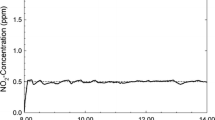Abstract
The aims of this work were (1) to determine the dose-response relationship between ex vivo exposure to oxidizing pollutants such as nitrogen dioxide (NO2), the aldehyde acrolein, and ozone (O3), and the reactivity to agonists in isolated human bronchial smooth muscle; and (2) to investigate the alterations in the cellular mechanisms of human airway smooth muscle contraction induced by such exposures. Experiments were performed in isolated human bronchi obtained at thoracotomy. Isometric contraction in response to a variety of agonists was compared between pollutant-exposed preparations and paired controls. Short exposures to NO2, acrolein, or O3 altered the subsequent airway smooth muscle responsiveness in a dose-dependent manner. The cellular mechanisms producing the airway hyperresponsiveness observed in vitro are shared by the three pollutants and include alterations in airway smooth muscle excitation-contraction coupling as well as indirect effects on neutral endopeptidase activity.
Similar content being viewed by others
Abbreviations
- ACh:
-
acetylcholine
- CCRC:
-
cumulative concentration-response curve
- KH:
-
Krebs-Henseleit solution
- NEP:
-
neutral endopeptidase
- NKA:
-
neurokinin A
- SP:
-
substance P
References
Ben-Jebria A, Marthan R, Savineau JP. Effect of in vitro nitrogen dioxide exposure on human bronchial smooth muscle response. Am Rev Respir Dis. 1992;146:378–82.
Ben-Jebria A, Marthan R, Rossetti M, Savineau JP, Ultman JS. Human bronchial smooth muscle responsiveness after in vitro exposure to acrolein. Am J Respir Crit Care Med. 1994;149:382–6.
Coburn RF, Baron CB. Coupling mechanisms in airway smooth muscle. Am J Physiol. 1990;258:L119–33.
Devlin RB, McDonnell WF, Mann R et al. Exposure of humans to ambient levels of ozone for 6.6 hours causes cellular and biochemical changes in the lung. Am J Respir Cell Mol Biol. 1991;4:72–81.
Farley JM. Inhaled toxicants and airway hyperresponsiveness. Annu Rev Pharmacol Toxicol. 1992;32:67–88.
Gezleichter TR, Witschi H, Last JA. Concentration-response relationship of rat lungs to exposure to oxidant air pollutants: a critical test of Haber's law for ozone and nitrogen dioxide. Toxicol Appl Pharmacol. 1992;112:73–80.
Holtzman MJ, Cunningham JH, Sheller JR, Irsigler GB, Nadel JA, Boushey HA. Effect of ozone on bronchial reactivity in atopic and non atopic subjects. Am Rev Respir Dis. 1979;120:1059–67.
Roux E, Savineau JP, Marthan R. Human and rat airway smooth muscle responsiveness after ozone exposure in vitro. (Abstract). Cell Biol Toxicol. 1996;12:377.
Author information
Authors and Affiliations
Rights and permissions
About this article
Cite this article
Marthan, R., Roux, E. & Savineau, JP. Human bronchial smooth muscle responsiveness after in vitro exposure to oxidizing pollutants. Cell Biol Toxicol 12, 245–249 (1996). https://doi.org/10.1007/BF00438153
Accepted:
Issue Date:
DOI: https://doi.org/10.1007/BF00438153




